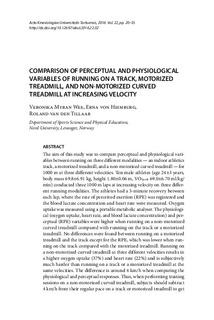Comparison of perceptual and physiological variables of running on a track, motorized treadmill, and non-motorized curved treadmill at increasing velocity
Journal article, Peer reviewed
Permanent lenke
http://hdl.handle.net/11250/2433427Utgivelsesdato
2016Metadata
Vis full innførselSamlinger
Originalversjon
Wee, V.M., Von Heimburg, E.D. & van den Tillaar, R.J.W. (2016). Comparison of perceptual and physiological variables of running on a track, motorized treadmill, and non-motorized curved treadmill at increasing velocity. Acta Kinesiologiae Universitatis Tartuensis, 22, 20-35. doi: 10.12697/akut.2016.22.02Sammendrag
The aim of this study was to compare perceptual and physiological variables between running on three different modalities – an indoor athletics track, a motorized treadmill, and a non-motorized curved treadmill – for 1000 m at three different velocities. Ten male athletes (age 24±3 years, body mass 69.8±6.91 kg, height 1.80±0.06 m, VO2peak 69.0±6.70 ml/kg/ min) conducted three 1000 m laps at increasing velocity on three different running modalities. The athletes had a 3-minute recovery between each lap, where the rate of perceived exertion (RPE) was registered and the blood lactate concentration and heart rate were measured. Oxygen uptake was measured using a portable metabolic analyser. The physiological (oxygen uptake, heart rate, and blood lactate concentration) and perceptual (RPE) variables were higher when running on a non-motorized curved treadmill compared with running on the track or a motorized treadmill. No differences were found between running on a motorized treadmill and the track except for the RPE, which was lower when running on the track compared with the motorized treadmill. Running on a non-motorized curved treadmill at three different velocities results in a higher oxygen uptake (37%) and heart rate (22%) and is subjectively much harder than running on a track or a motorized treadmill at the same velocities. The difference is around 4 km/h when comparing the physiological and perceptual responses. Thus, when performing training sessions on a non-motorized curved treadmill, subjects should subtract 4 km/h from their regular pace on a track or motorized treadmill to get the same response considering oxygen uptake, heart rate, RPE and blood lactate concentration.
